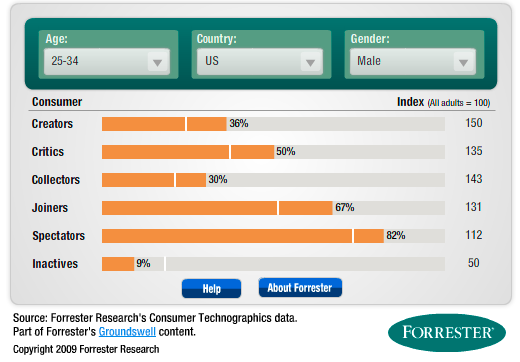Researching Social Media Engagement
Thinking back to the original questions in this Research section – how we do know what are ideal user’s habits are when it comes to social technologies?
Fortunately, Forrester has developed a simple online tool (for free!) that let’s us tap their research data by filtering on a basic demographic level for some insights into the makeup of our audience.
Let’s return to our user persona of Chris Sankowski, who is the avid Moleskine user we’re seeking to attract to our add-on product. We know he is a male, 28, and living in the U.S. Ideally, we could plug in all the other demographic and psychographic data but this gives us a good starting point for making some assumptions on this group’s social media habits.
So, we see the following:
- Creators – 36%
- Critics – 50%
- Collectors – 30%
- Joiners – 67%
- Spectators – 82%
- Inactives – 9%
This data can be great to know but how do we put it in action? Let’s see if we can better inform our general strategy for our social media roll-out.
Creators and User Generated Content (UGC)
The data for this demographic skews higher than the general average for Creators (24% vs. 36%).
- We know our user persona is correct for having Chris being active at publishing on a blog at least once a month.
- This tell us that we might be able to get this group to help us with some User Generated Content (UGC) for our website in the form of photos or video of our product in use.
- Better yet, we might even get some submissions on how our product helped them rise in their careers as a guest blog post.
Conversationalists and Twitter
While the tool does not allow for Conversationalists, chances are they would be at least 36% – most likely higher. Obviously, a Twitter presence is a good bet here.
Critics, Brand Experience and Online Reviews
The fascinating part is that Critics come in at roughly 1 in 2 (compared to 36% in the general survey). This is a highly engaged audience, so we absolutely have to be on our guard for monitoring our brand online and participating in the conversation. There will be little room for our Moleskine add-on product to fail and last long with this group. We predicted as much already in the previous chapter – good to see our user persona assumption validated.
How to Compete with Critics On Our Side
- If we nail the design and build a strong brand experience, we make it incredibly difficult for cheap products to compete with us and last based on price (Remember, we like to win on brand and never on price).
- With a poor product, this crowd will simply tear it apart and Google will index the results given how active they are as Creators.
- Nielsen in 2009 found out that 70% of online users trust 3rd party reviews.
- Brand demise will follow shortly.
So, to harness this insight, we might want to ship our product with a gentle ask that says, “If you love it, will you show it?”
- We will show our gratitude in turn with tweeting their online reviews and posting them to our Facebook fan page but at a rate of only twice a month to avoid fatigue with puffing ourselves up.
- Knowing they are likely to comment, our Facebook page could kick off a lively conversation if we nail the content creation piece focused around their emotional aspirations from our user persona.
Spectators and Content Strategy
Finally, we see that 8 out of 10 are Spectators (compared to 73% of general survey). This shows that the majority of current and potential users will be watching us. We have a tremendous opportunity with our content strategy to provide great value in return for their time. Blog posts, interviews, photos, and videos around helping the on the go motivated professional succeed in their career have a good chance for being consumed. We will test for engagement with our website analytics, retweets, and Facebook/Google Plus shares.
Eventually, this will be the cornerstone that builds our brand.
Key takeaway: By layering Social Technographics research on top of our user persona that already includes interviews, demographics, and psychographics, we can have confidence our social media efforts will resonate with our target market.

